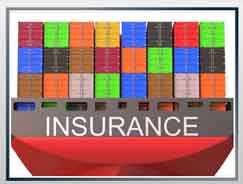So-called blockchain technology is already being piloted for global track and trace, with a focus on the global food supply chain.
Notably, IBM recently announced it has signed 10 food industry companies – on top of Walmart in 2016 – to test the technology for tracking. Earlier, IBM had also announced it had tied up with Maersk Line, the world's largest ocean container shipping company, in a plan to work with a network of shippers, freight forwarders, ocean carriers, ports and customs authorities to build the new blockchain-based global trade digitization solution for increased visibility and automation of processes, the two lead companies said at the time.
Supply Chain Digest Says... |
|
|
Now, another blockchain assault on a traditional – and perhaps dated – process in the global shipping sector: buying and managing maritime insurance.
Before we detail that, what is blockchain technology? In great simplicity and perhaps not enough to really well explain it, nevertheless, here is SCDigest's take.
A blockchain is a data structure that makes it possible to create a digital ledger of transactions and share it among a distributed network of users. It uses cryptography to allow each participant on the network to manipulate the ledger in a secure way without the need for a central managing authority, even across disparate companies.
Once a block of data is recorded on the blockchain ledger, it's extremely difficult to change or remove. When someone wants to add to it, participants in the network - all of which have copies of the existing blockchain - run special algorithms to evaluate and verify the proposed transaction. If a majority of nodes agree that the transaction looks valid - for example, that identifying information matches the blockchain's history - then the new transaction will be approved and a new block added to the chain.
This setup means the entire network, rather than a central authority, is responsible for ensuring the validity of each transaction.
Now, back to the maritime insurance play. It was announced this week that a joint venture had been formed among Microsoft, Maersk Line, accounting firm EY and blockchain technology firm Guardtime to apply blockchain to the currently complex world of marine insurance.
The solution will built using Microsoft's cloud-based platform called Azure, which competes with IBM's cloud offering, among many others. The program will involve the creation of a shared database that logs information about shipments – and importantly potential risks - in order to help ships comply with insurance regulations.
The partnership also says the database would make this information transparent across what is a complex network of parties and variables.
(See More Below)
|
CATEGORY SPONSOR: SOFTEON |
|
|
| |
|
|
"The platform's capabilities include the ability to create and maintain asset data from multiple parties; to link data to policy contracts; to receive and act upon information that results in a pricing or a business process change; to connect client assets, transactions and payments; and to capture and validate up-to-date first notification or loss data," a press release said.
 In an interview with cable channel CNBC, an EY executive said that that securing marine insurance data with blockchain was necessary due to the "complete inefficiency" of the industry. In an interview with cable channel CNBC, an EY executive said that that securing marine insurance data with blockchain was necessary due to the "complete inefficiency" of the industry.
And it is a huge market. EY also said shipping companies pay $30 billion in premiums annually.
As reported in American Shipper magazine, the idea is not just to eliminate paper-based documentation and the resulting information latency by moving it to a decentralized electronic ledger.
The more revolutionary idea is to enable more dynamic types of insurance depending on unforeseen occurrences.
For instance, if a cargo ship is entering a war zone or area beset by piracy, insurers could offer real-time coverage to reflect that specific situation, a risk that could vary day by day.
Guardtime CEO Mike Gault took this idea further in American Shipper, positing this scenario: "If there's a storm in their [a ship's] trajectory, is it better to go around the storm or re-evaluate their insurance and make sure they're covered for any risk."
Blockchain can also be used to get maritime claims can paid faster. It can take years for claims to be settled.
"With this platform will ensure that everyone has the right documentation, so the claim can be paid in a matter of hours or days," Gault added.
Reuters reported that the platform is already built and is planned for release in January, after having already been tested in the field.
Is the maritime insurance industry in need of a technology shake-up? Let us know your thoughts at the Feedback section below.
Your Comments/Feedback
|